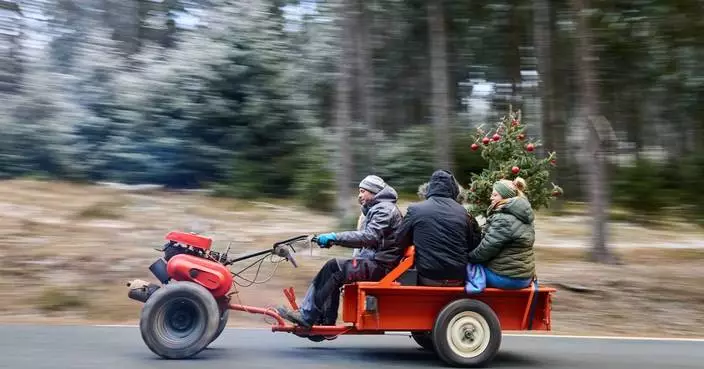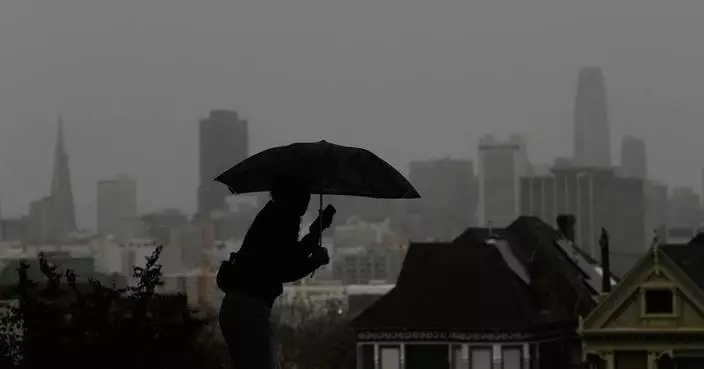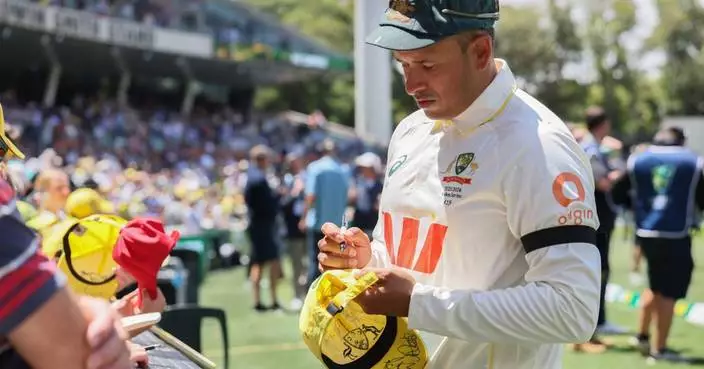OAKMONT, Pa. (AP) — Thriston Lawrence walked onto the 10th tee box at 2:20 p.m. to begin his second round at the U.S. Open with his name near the top of the front page of the leaderboard.
Nearly six hours and 73 shots later, the South African's name wasn't so high. And his round still wasn't quite over.
Click to Gallery
Taylor Pendrith, of Canada, waits tee off on the 12th hole during the second round of the U.S. Open golf tournament at Oakmont Country Club Friday, June 13, 2025, in Oakmont, Pa. (AP Photo/Gene J. Puskar)
Thriston Lawrence, of South Africa, lines up a putt on the 12th hole during the second round of the U.S. Open golf tournament at Oakmont Country Club Friday, June 13, 2025, in Oakmont, Pa. (AP Photo/Seth Wenig)
Scottie Scheffler plays out of the Church Pews bunker on the third hole during the second round of the U.S. Open golf tournament at Oakmont Country Club Friday, June 13, 2025, in Oakmont, Pa. (AP Photo/Charlie Riedel)
Viktor Hovland, of Norway, reacts after missing a putt on the 18th hole during the second round of the U.S. Open golf tournament at Oakmont Country Club Friday, June 13, 2025, in Oakmont, Pa. (AP Photo/Gene J. Puskar)
Viktor Hovland, of Norway, reacts after making double bogey on the second hole during the second round of the U.S. Open golf tournament at Oakmont Country Club Friday, June 13, 2025, in Oakmont, Pa. (AP Photo/Charlie Riedel)
Brooks Koepka prepares to putt on the 10th hole during the second round of the U.S. Open golf tournament at Oakmont Country Club Friday, June 13, 2025, in Oakmont, Pa. (AP Photo/Seth Wenig)
Viktor Hovland, of Norway, hits from a bunker on the second hole during the second round of the U.S. Open golf tournament at Oakmont Country Club Friday, June 13, 2025, in Oakmont, Pa. (AP Photo/Charlie Riedel)
Welcome to Oakmont, where one of golf's toughest tests began with two — or three in the case of Lawrence and a handful of others still on the course when play was suspended at around 8:15 p.m. as a storm passed through — of the sport's longest days.
Lawrence was standing over a 4-foot par putt in the middle of a downpour for a 4-over 74 when the horn blew, 5 hours, 55 minutes after his scheduled tee time.
He turned to ask an official if he could putt out. When the answer came back “no," he marked his ball and hustled with umbrella in hand to the clubhouse.
"Overall, I played nicely, but frustrating day because it felt like we were out there for seven hours,” Lawrence said.
Close enough.
While the late dash of weather didn't help, the pace at the sprawling par-70 layout carved into a hilly slice of Western Pennsylvania so big it's divided by an interstate spared no one.
Not world No. 1 Scottie Scheffler, who admitted it "it felt long to me,” after taking 5 1/2 hours to put together a 1-over 71 on Friday morning that left him 4 over for the tournament, seven shots behind leader Sam Burns.
Not first-round leader J.J. Spaun, who needed nearly 5 hours, 40 minutes to finish up a 72 that put him in the final group with Burns on Saturday.
Yet Scheffler didn’t find himself checking his watch too often, not even during waits that stretched to 15 minutes or more between shots.
“I’ve got too many concerns other than the pace it takes to get around this place,” he said with a shrug.
By comparison, Scheffler and playing partners Viktor Hovland and Collin Morikawa might have gotten off easy.
It took Lawrence’s group well over an hour to get through three holes, thanks to a logjam on the tee at the par-5 12th. Players were frequently forced to wait 20 minutes or more to hit their tee shot while members of the group ahead of them either waited for the green to clear in hopes of reaching it in two shots or wandered through the 5-inch-plus rough in hopes of finding their ball. (Hardly a given).
Unless you stick it close (and you probably won't), there's no chance at making up times on greens so fast and so frustrating that Edward S. Stimpson invented his now-eponymous and ubiquitous tool to measure their actual speed.
Even seemingly innocuous approach shots aren't immune, as qualifier Will Chandler found out Friday in the second round when his wedge into the par-4 second hole landed a few paces from the back of the green, then hit reverse and kept rolling for 40 seconds before settling back in the fairway.
Part of the issue at Oakmont is the combination of the layout — where players literally have to cross a bridge over an interstate to get from the first green to the second tee, and again while going from the eighth green to the ninth tee — and the decisions the course forces you to make.
There's typically a backup at the par-4 17th, for example, because at around 300 yards (albeit uphill ones) it's drivable, meaning the group on the green typically has to putt out before the group behind them can go.
Throw in the stakes — the lure of golf immortality (or at the very least, a healthy paycheck for making the cut) for the pros and the walk of a lifetime for amateurs like dentist turned qualifier Matt Vogt — and yeah, things can drag on a bit.
Hovland's second trip through Oakmont was an adventure. His 1-under 69 included only eight pars. There was an eagle thanks to a pitch-in on 17, five birdies, three bogeys, and a double.
During a regular tour event, when scores are lower and the pace is a far more palatable five hours or less, Hovland isn't sure he would have been able to keep things from spiraling out of control after the second, when a poor drive into the right rough was followed by a mangled pitch into a bunker and eventually a double bogey that threatened to rob him of the momentum he'd build over his first 10 holes.
“If it would have happened at another tournament, for example, I could have potentially lost my mind there a little bit,” he said. “But I felt like I kept things together very well.”
The fact Hovland had time to let his frustration melt away before his driver on the third tee may have helped. The 27-year-old Norwegian knows his game well enough to know that he tends to speed things up when a round threatens to go sideways, and not in a good way.
There was no chance of that on Friday.
“Yeah, you might have had a bad hole on the last hole and then you’re sitting on the tee box for 10-20 minutes,” he said. “At least it gives you a good opportunity to get that out of your system and reset and think about the next shot.”
Maybe the rhythm of the day will feel more like normal on Saturday, when the field goes out in pairs instead of threesomes. Or maybe not. Considering the lure of history, he's not going to complain.
“Honestly, we play pretty slow on Tour anyway,” he said with a smile. “So what’s another 40 minutes to go around Oakmont.”
AP golf: https://apnews.com/hub/golf

Taylor Pendrith, of Canada, waits tee off on the 12th hole during the second round of the U.S. Open golf tournament at Oakmont Country Club Friday, June 13, 2025, in Oakmont, Pa. (AP Photo/Gene J. Puskar)

Thriston Lawrence, of South Africa, lines up a putt on the 12th hole during the second round of the U.S. Open golf tournament at Oakmont Country Club Friday, June 13, 2025, in Oakmont, Pa. (AP Photo/Seth Wenig)

Scottie Scheffler plays out of the Church Pews bunker on the third hole during the second round of the U.S. Open golf tournament at Oakmont Country Club Friday, June 13, 2025, in Oakmont, Pa. (AP Photo/Charlie Riedel)

Viktor Hovland, of Norway, reacts after missing a putt on the 18th hole during the second round of the U.S. Open golf tournament at Oakmont Country Club Friday, June 13, 2025, in Oakmont, Pa. (AP Photo/Gene J. Puskar)

Viktor Hovland, of Norway, reacts after making double bogey on the second hole during the second round of the U.S. Open golf tournament at Oakmont Country Club Friday, June 13, 2025, in Oakmont, Pa. (AP Photo/Charlie Riedel)

Brooks Koepka prepares to putt on the 10th hole during the second round of the U.S. Open golf tournament at Oakmont Country Club Friday, June 13, 2025, in Oakmont, Pa. (AP Photo/Seth Wenig)

Viktor Hovland, of Norway, hits from a bunker on the second hole during the second round of the U.S. Open golf tournament at Oakmont Country Club Friday, June 13, 2025, in Oakmont, Pa. (AP Photo/Charlie Riedel)
SEOUL, South Korea (AP) — North Korea on Thursday displayed apparent progress in the construction of a nuclear-powered submarine, with state media photos showing a largely completed hull, as leader Kim Jong Un condemned rival South Korea’s push to acquire the technology.
North Korea’s official Korean Central News Agency said Kim visited a shipyard to inspect the construction of what the North describes as an 8,700-ton-class nuclear-propelled submarine, which the leader has called a crucial step in the modernization and nuclear armament of North Korea’s navy. The North has indicated it plans to arm the submarine with nuclear weapons, calling it a “strategic guided missile submarine” or a “strategic nuclear attack submarine.”
During the visit, Kim described South Korea’s efforts to acquire its own nuclear-powered submarine, which have been backed by U.S. President Donald Trump, as an “offensive act” that severely violates the North’s security and maritime sovereignty.
He said that the South Korean plan further underscores the need to advance and nuclear-arm North Korea’s navy, and claimed that the completion of his nuclear-powered submarine would be an “epoch-making” change in strengthening its nuclear war deterrent against what he called enemy threats.
The agency did not specify when Kim visited the shipyard but released photos showing him inspecting a huge, burgundy-colored vessel, coated with what appears to be anti-corrosion paint, under construction inside an assembly hall with senior officials and his daughter. It was the first time North Korean state media had released images of the submarine since March, when they mostly showed the lower sections of the vessel.
It was not immediately clear how close North Korea is to completing the vessel. But because submarines are typically built from the inside out, the release of what appears to be a largely completed hull suggests that many core components, including the engine and possibly the reactor, are already in place, said Moon Keun-sik, a submarine expert at Seoul’s Hanyang University.
“Showing the entire vessel now seems to indicate that most of the equipment has already been installed and it is just about ready to be launched into the water,” said Moon, a former submarine officer in the South Korean navy, who believes the North Korean submarine could possibly be tested at sea within months.
A nuclear-powered submarine was one item on a long wish list of sophisticated weaponry that Kim announced during a major political conference in 2021 to cope with what he called growing U.S.-led military threats. Other weapons were solid-fueled intercontinental ballistic missiles, hypersonic weapons, spy satellites and multi-warhead missiles.
North Korea has conducted a series of tests to develop some of those systems and recently unveiled a new naval destroyer, which Kim hailed as a major step toward expanding the operational range and preemptive strike capabilities of the country’s nuclear forces.
If North Korea obtains a submarine capable of operating stealthily for extended periods and launching missiles from underwater, it would be a worrying development for its neighbors, as such launches would be difficult to detect in advance. But there have been questions about whether North Korea, a heavily sanctioned and impoverished country, could get resources and technology to build nuclear-powered submarines.
Some experts say North Korea’s recent alignment with Russia — including sending thousands of troops and military equipment to support President Vladimir Putin’s war in Ukraine — may have helped it to receive crucial technologies in return.
While some analysts suspect North Korea may have sought a reactor from Russia, possibly from a retired Russian submarine, Moon said it's more likely that North Korea designed its own reactor, while possibly receiving some technological assistance from Russia.
During a summit with Trump in November, South Korean President Lee Jae Myung called for U.S. support for South Korea’s efforts to acquire nuclear-powered submarines, while reaffirming a commitment to increase defense spending to ease the burden on the United States.
Trump later said that the United States is open to sharing closely held technology to allow South Korea to build a nuclear-powered submarine, but it’s not immediately clear where and when the vessel would be built and how Seoul would get the nuclear fuel and reactor technology required.
In a separate report, KCNA said Kim on Wednesday supervised tests of new antiair missiles fired into the sea. South Korea’s Joint Chiefs of Staff later said it had detected the North launching several missiles from an eastern coastal town, and that South Korean and U.S. intelligence agencies were assessing the details of the weapons.
Tensions on the Korean Peninsula have worsened in recent years as Kim accelerated his military nuclear program and deepened alignment with Moscow following Russia’s invasion of Ukraine. His government has repeatedly dismissed calls by Washington and Seoul to revive negotiations aimed at winding down his nuclear and missile programs, which derailed in 2019 following a collapsed summit with Trump during the American president’s first term.

In this photo provided by the North Korean government, a test of a long-range anti-air missile is launched towards its eastern sea, as seen from an undisclosed location in North Korea, Wednesday, Dec. 24, 2025. Independent journalists were not given access to cover the event depicted in this image distributed by the North Korean government. The content of this image is as provided and cannot be independently verified. Korean language watermark on image as provided by source reads: "KCNA" which is the abbreviation for Korean Central News Agency. (Korean Central News Agency/Korea News Service via AP)

In this undated photo provided Thursday, Dec. 25, 2025, by the North Korean government, its leader Kim Jong Un, with his daughter, inspects a nuclear-powered submarine under construction at an undisclosed location in North Korea. Independent journalists were not given access to cover the event depicted in this image distributed by the North Korean government. The content of this image is as provided and cannot be independently verified. Korean language watermark on image as provided by source reads: "KCNA" which is the abbreviation for Korean Central News Agency. (Korean Central News Agency/Korea News Service via AP)

In this undated photo provided Thursday, Dec. 25, 2025, by the North Korean government, its leader Kim Jong Un, third left, visits a shipyard as he inspects a nuclear-powered submarine under construction at an undisclosed location in North Korea. Independent journalists were not given access to cover the event depicted in this image distributed by the North Korean government. The content of this image is as provided and cannot be independently verified. Korean language watermark on image as provided by source reads: "KCNA" which is the abbreviation for Korean Central News Agency. (Korean Central News Agency/Korea News Service via AP)

In this undated photo provided Thursday, Dec. 25, 2025, by the North Korean government, its leader Kim Jong Un inspects a nuclear-powered submarine under construction at an undisclosed location in North Korea. Independent journalists were not given access to cover the event depicted in this image distributed by the North Korean government. The content of this image is as provided and cannot be independently verified. Korean language watermark on image as provided by source reads: "KCNA" which is the abbreviation for Korean Central News Agency. (Korean Central News Agency/Korea News Service via AP)

In this undated photo provided Thursday, Dec. 25, 2025, by the North Korean government, its leader Kim Jong Un inspects a nuclear-powered submarine under construction at an undisclosed location in North Korea. Independent journalists were not given access to cover the event depicted in this image distributed by the North Korean government. The content of this image is as provided and cannot be independently verified. Korean language watermark on image as provided by source reads: "KCNA" which is the abbreviation for Korean Central News Agency. (Korean Central News Agency/Korea News Service via AP)




























